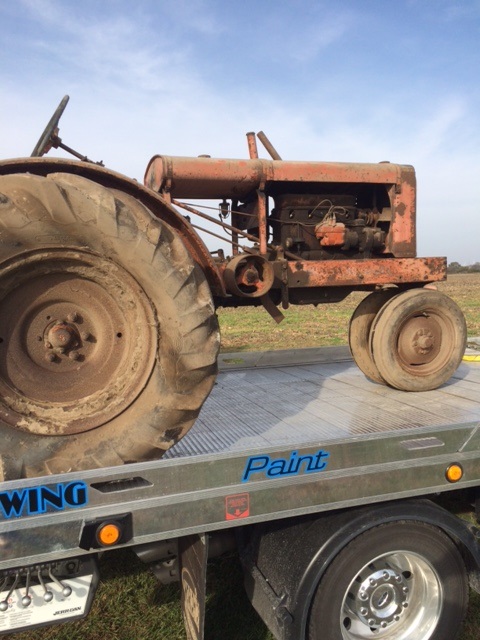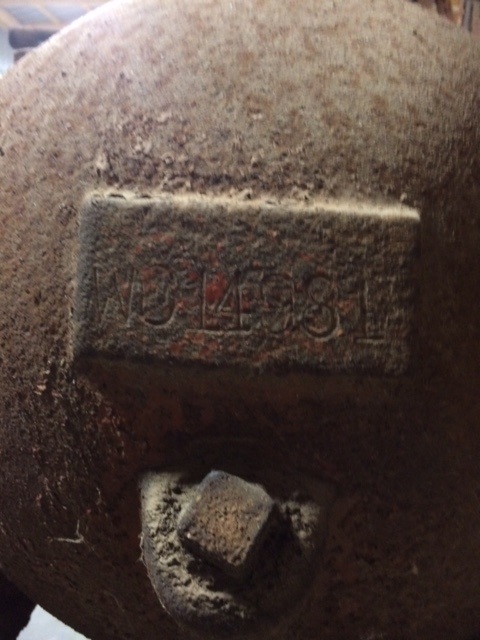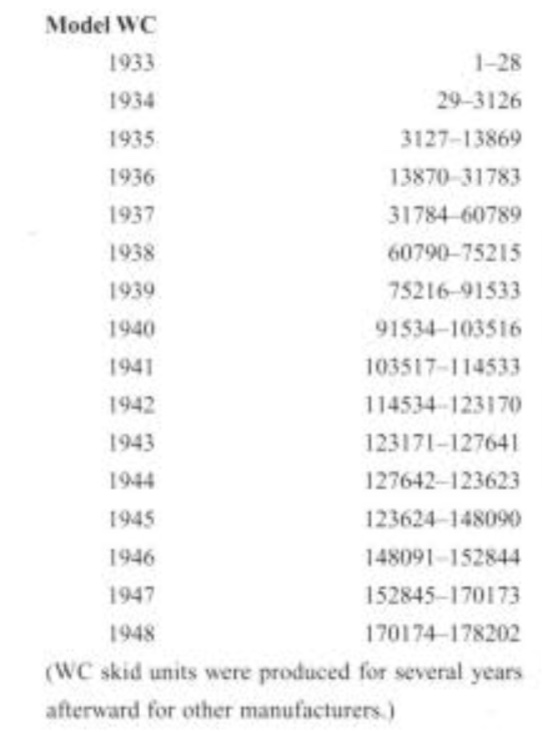Unstated WC wheels
Printed From: Unofficial Allis
Category: Allis Chalmers
Forum Name: Farm Equipment
Forum Description: everything about Allis-Chalmers farm equipment
URL: https://www.allischalmers.com/forum/forum_posts.asp?TID=133261
Printed Date: 18 Dec 2025 at 6:10am
Software Version: Web Wiz Forums 11.10 - http://www.webwizforums.com
Topic: Unstated WC wheels
Posted By: tractorhead9542
Subject: Unstated WC wheels
Date Posted: 01 Jan 2017 at 9:13am
|
Hello all. We have a graveyard full of WCs and decided to start putting a few of them back together. I have done a pile of work to a 36 and am unsure what the correct rear rim is for that year. I have both the 24 inch dish and spoke sets but I'm sure which to put on this one. 35 is F & H spoke and 37 is dish, but 36? Currently it is front rubber, rear steel and I like it that way but my back and yard do not! ------------- The road to nowhere...leads to me |
Replies:
Posted By: MNLonnie
Date Posted: 01 Jan 2017 at 9:24am
|
1936 would be 24" spokes. Serial # 59636 in 1937 started with the dish wheels. ------------- Waukesha B, B, IB, G, styled WF, D17, 615 backhoe, M7, 2-Oliver OC3's, 5 Ford Model T's, 3 Model A Fords, 34 Ford coupe, 57 T-Bird |
Posted By: ecclap
Date Posted: 01 Jan 2017 at 10:32am
| If you're going for accuracy, make sure that the round spokes you have are the correct ones for an WC. They will have the casting number HC46A on the inside of the hub between the spokes. Other wheels will fit if accuracy isn't important. |
Posted By: tractorhead9542
Date Posted: 02 Jan 2017 at 8:37am
|
Thanks for the info. My A-C knowledge is extensive but that is impressive. ------------- The road to nowhere...leads to me |
Posted By: Brian F(IL)
Date Posted: 03 Jan 2017 at 8:34am
This is our family's 1936 WC. Just got it out of the crib this fall after sitting there for 34 years. I believe it originally came with steel wheels and the rubber tires/wheels came later. FWIW. |
Posted By: Bill Long
Date Posted: 03 Jan 2017 at 9:35am
|
Brian, Nice looking "flat top" WC. You know, that is the first Allis Chalmers Tractor my father sold. "Flat Tops" have a special place in my heart. Take good care of it. It is a FAMILY TRACTOR Good Luck! Bill Long
|
Posted By: CrestonM
Date Posted: 03 Jan 2017 at 9:42am
| Brian, are those the correct rear wheels for a 36? I've been following this thread, but I'm still a little confused. Like when the OP said "35 is F & H spoke and 37 is dish". I know what the spoke wheels look like, but are those in your photo the "dish" wheels? I have a 37 WC with styled rear wheels and I'd like to get correct wheels to go on it. |
Posted By: tractorhead9542
Date Posted: 03 Jan 2017 at 9:43am
|
Those are the "dish" style. I have a set if interested ------------- The road to nowhere...leads to me |
Posted By: ecclap
Date Posted: 03 Jan 2017 at 10:11am
According to the Parts Catalog 59636 started the one-piece dish style rear wheels. That's when the round spokes ended from the factory. Everyone has to decide for themselves what wheels they want to put on. Absent any specific shipping info for each individual tractor, we can only tell how things were shipped by the serial breaks in the parts books. You also have to keep in mind that dealers were probably free to swap wheels to suit the needs of the customer. French and Hecht also sold their spoked rims aftermarket well into the 40's and possibly the early 50's. They lost most of the contracts to supply rims as original equipment so they turned to the aftermarket to continue selling them. If you had a tractor on steel yet in the late 40's you had many options to convert it to rubber. If you went to your dealer they would probably sell you whatever was currently in stock that would be a proper replacement part. If you went to a tire shop or hardware store, they would sell you F&H spoked wheels or they would cut down your steel and weld rims on for a lower cost. That's why not every tractor will follow the serial breaks, especially tractors shipped on steel.
|
Posted By: Gerald J.
Date Posted: 03 Jan 2017 at 10:35am
|
AC was a leader in the mid 30s in rubber tractor tires showing that they caused less compaction in the fields and took less fuel to do the same work. I don't have proof, but based on their plow books and options its very likely than when ordering a tractor that wheels were one of the options to select rubber or steel, and since there appears to have been more than one wheel style for rubber possibly that style was a choice along with tire size. There probably was a standard wheel that changed by serial number but the options likely continued. During WW2 several tractor makers went back to steel wheels as an option because rubber for tires was destined primarily for military uses, not domestic uses, though farm use got a little priority over car tires. So after the war, there could easily have been tractors only 2 or 3 years old with steel wheels. Its highly likely that many a spoked steel wheel had the steel cut off and a rim welded on for a quick and low cost switch to rubber. Gerald J. |
Posted By: KenBWisc
Date Posted: 03 Jan 2017 at 10:37am
|
What are the differences between the rod and flat spoke rims?
------------- '34 WC #629, '49 G, '49 B, '49 WD, '62 D-19, '38 All Crop 60 and still hunting! |
Posted By: ecclap
Date Posted: 03 Jan 2017 at 11:40am
Any flat spoke wheel on the rear was formerly a steel wheel. If you look at where the spokes meet the rim there will be welds at that connection. Factory spokes from F&H were hot forged into both the hub and the rim or steel tire. The WC was available with both flat steel and skeleton or tip-toe steel wheels produced by French and Hecht. The hub casting number will be HC119. There is also a pretty rare offset steel wheel. Factory or aftermarket spoked wheels produced by F&H for rubber tires are all round spokes. So if you have flat spokes, they started out as steel wheels.
|
Posted By: Brian F(IL)
Date Posted: 03 Jan 2017 at 12:49pm
It's probably like ecclap said, the dished wheels were obtained later and were not original equipment. My great-grandfather was known to be frugal (aka tight) and my guess is the steel wheels were the original equipment for this tractor. Sometime later (my guess again) is that they chose to buy some rubber tired wheels for it and the dish style is what the dealer had available. I'll post some more pictures in a new thread/post. Brian
|
Posted By: Unit3
Date Posted: 03 Jan 2017 at 3:33pm
|
Brian, double check your S.N. Your hood doesn't have the curved tin that goes down to the radiator. Could yours be a 1935 or maybe an early 1936? Also, if you had flat spoke steel wheel, they were painted orange. Round spoke for rubber tires were painted black. I have seen one early WC with factory green round spoke for rubber tires. ------------- 2-8070FWA PS/8050PS/7080/7045PS/200/D15-II/2-WD45/WD/3-WC/UC/C |
Posted By: Brian F(IL)
Date Posted: 03 Jan 2017 at 4:10pm
Ours is an early 1936 model, serial # 14981. Again, not sure about what might have happened to the hood... was well before my time around the farm.  |
Posted By: dawntreader74
Date Posted: 03 Jan 2017 at 4:42pm
| brian' your #14981 is a good one 1934 should have 24'' spoked or steel' don't know wear some look up these numbers' but there not right' i also have two 34's yours looks good. the black book from out of the plant don't lie''#22816 starts 1935' will look for your tractor at some shows this summer. |
Posted By: MNLonnie
Date Posted: 03 Jan 2017 at 4:57pm
|
Rearend could have been swapped out at some point. #14981 is not a 1934 WC. Could you post the complete serial # list for WC's where you found that information? By the way you never did let us know the serial # of your 1933 WC?? ------------- Waukesha B, B, IB, G, styled WF, D17, 615 backhoe, M7, 2-Oliver OC3's, 5 Ford Model T's, 3 Model A Fords, 34 Ford coupe, 57 T-Bird |
Posted By: CALEBnOK
Date Posted: 03 Jan 2017 at 5:13pm
Green wheels werent factory installed. Allis painted them black from the factory. I assume they recieved them bare from F&H. If the dealer installed a set of F&h wheels a used or new tractor in the 1930's they were dark green (this was F&H's color) during that period. Our '35 UC has a set of F&h round spokes and they are dark green. My grandad bought the tractor during the summer of 1941 with those wheels. It came new on steel. We know this because 4th gear was blocked off in the transmission until the 1950's. Plate removed when a new clutch was installed. I know farmalls (regulars, f20 etc on steel were shipped with no lugs or guide rings installed. They were included in a big cloth bag for the dealer to install. |
Posted By: dawntreader74
Date Posted: 03 Jan 2017 at 5:45pm
| 14981 34 in the wis' plant book i got from a old timer that worked there for years an bought a farm 2 miles from us. helped me work on ac tractors' gave me the books when he could'nt see good anymore. it went from 33-48' i was about 13' years old at the time' i can't call it a lier . what year is 1006? |
Posted By: MNLonnie
Date Posted: 03 Jan 2017 at 6:15pm
|
1006 is 1934 ------------- Waukesha B, B, IB, G, styled WF, D17, 615 backhoe, M7, 2-Oliver OC3's, 5 Ford Model T's, 3 Model A Fords, 34 Ford coupe, 57 T-Bird |
Posted By: Tom IA
Date Posted: 03 Jan 2017 at 6:29pm
| I have a 36 14102 spoked rear wheels no curved tin on hood with 5 bolt rims on front, my question are the front rims correct ? |
Posted By: MNLonnie
Date Posted: 03 Jan 2017 at 6:41pm
|
The 5 bolt rims were the newest version. They used 17" spoked wheels until 1936 (serial #23529),6 bolt wheels until 1937(serial #59627) and after that was the 5 bolt. They made way more 5 bolt than any other so you have the most common replacement for the 17" that yours would have come with. 17's can be pricey. ------------- Waukesha B, B, IB, G, styled WF, D17, 615 backhoe, M7, 2-Oliver OC3's, 5 Ford Model T's, 3 Model A Fords, 34 Ford coupe, 57 T-Bird |
Posted By: ecclap
Date Posted: 03 Jan 2017 at 6:53pm
This is the list I see printed in all of the Allis books including the Norm Swinford book. Is this not accurate?  |
Posted By: tractorhead9542
Date Posted: 03 Jan 2017 at 7:36pm
|
Wow, looks like I started the giant serial number party ------------- The road to nowhere...leads to me |
Posted By: MNLonnie
Date Posted: 03 Jan 2017 at 7:47pm
|
I'm pretty sure everyone who has a WC uses the serial # list that ecclap just posted, except for one person apparently? ------------- Waukesha B, B, IB, G, styled WF, D17, 615 backhoe, M7, 2-Oliver OC3's, 5 Ford Model T's, 3 Model A Fords, 34 Ford coupe, 57 T-Bird |
Posted By: Unit3
Date Posted: 03 Jan 2017 at 7:52pm
|
CALEBnOK Thank you for the history on Green Wheels. That is great to know that they were repainted from green to black at AC. As for the curved tins, the U and UC got the bigger 318 engines and 3/4 fenders in mid year 1936. I wonder IF the curved tin were added to the WC, U, UC, and A in mid year 1936? Any thoughts on this? ------------- 2-8070FWA PS/8050PS/7080/7045PS/200/D15-II/2-WD45/WD/3-WC/UC/C |
Posted By: tractorhead9542
Date Posted: 03 Jan 2017 at 9:01pm
Alright guys. Let's not battle too hard  . Now the next one... When did Allis stop using side pipes on styled WCs? I have a 38 and two 39s out in the weeds. The 38 and a 39 have them, the other doesn't. Hmm... . Now the next one... When did Allis stop using side pipes on styled WCs? I have a 38 and two 39s out in the weeds. The 38 and a 39 have them, the other doesn't. Hmm...------------- The road to nowhere...leads to me |
Posted By: MNLonnie
Date Posted: 03 Jan 2017 at 9:07pm
|
The WC parts book shows side exhaust manifolds up to engine #106509 which in theory is late 1940. Engine #'s are just a theory remember. ------------- Waukesha B, B, IB, G, styled WF, D17, 615 backhoe, M7, 2-Oliver OC3's, 5 Ford Model T's, 3 Model A Fords, 34 Ford coupe, 57 T-Bird |
Posted By: tractorhead9542
Date Posted: 03 Jan 2017 at 9:15pm
|
Yeah, as far as I know there is no documentation of engine s/n. Let's keep in mind that a lot of these tractors have been changed, modified, butchered, or revamped over the years even prior to us getting our hands on them. In some cases who's to say what's actually right? Case in point- WCs with different wheels in the rear. Some of these discrepancies actually build character and a story behind the tractors life. ------------- The road to nowhere...leads to me |
Posted By: ecclap
Date Posted: 03 Jan 2017 at 9:27pm
|
[/QUOTE] Green wheels werent factory installed. Allis painted them black from the factory. I assume they recieved them bare from F&H. If the dealer installed a set of F&h wheels a used or new tractor in the 1930's they were dark green (this was F&H's color) during that period. Our '35 UC has a set of F&h round spokes and they are dark green. My grandad bought the tractor during the summer of 1941 with those wheels. It came new on steel. We know this because 4th gear was blocked off in the transmission until the 1950's. Plate removed when a new clutch was installed. I know farmalls (regulars, f20 etc on steel were shipped with no lugs or guide rings installed. They were included in a big cloth bag for the dealer to install.[/QUOTE] CalebnOK I'm trying to verify information that states from Jan. 1, 1934 to April 1, 1934 wheel orders were received from F&H in their current factory dark green color. After April 1, 1934 the wheels were painted black I'm assuming also by F&H. I have documented many original F&H wheels and you can often find their dark green color as the first layer of paint. The WC round spokes that are painted black don't seem to have the dark green under them. The orange steel wheels also don't seem to have any F&H base coat underneath. I have pics of original F&H wheels in both black and dark green so they used both but the dark green is more common. I have a good clean sample of this color from the inside of a front wheel hub that I am going to get color-matched at my paint supplier. F&H wheels sold aftermarket usually retained their base coat paint and they also had the part number of the wheel assembly stenciled on the rim for identification.
|
Posted By: dawntreader74
Date Posted: 03 Jan 2017 at 9:57pm
| in the book' is the same #'s that's on hear from 38 to 48' but not the same form 33 to 37'. now in the allis-chalmers' deutz allis corp book it's the same as the old wis' plant book' why?is this norm book the right numbers from 33 to37? |
Posted By: dawntreader74
Date Posted: 03 Jan 2017 at 10:01pm
| have 2 39's no hole in the hood' ex' out the side. the 40 that was bought new came out the hood |
Posted By: Kip-Utah
Date Posted: 03 Jan 2017 at 11:41pm
|
Our 1939 WC Hi-Crop and our 1941 WC both were side exit dual fuel manifolds.
------------- HANSEN'S OLD ORANGE IRON. Showing, Pulling, & Going!! |
Posted By: Unit3
Date Posted: 04 Jan 2017 at 12:02am
|
Did they use different manifolds for different fuels? This has been a fun posting. After reading these, I would bet the WC would have been the model with the most changes. ------------- 2-8070FWA PS/8050PS/7080/7045PS/200/D15-II/2-WD45/WD/3-WC/UC/C |
Posted By: ac hunter
Date Posted: 04 Jan 2017 at 8:59am
| Speaking of side pipes, does anyone make new pipes with the rectangular end or do I have to make one? Any idea how long it was originally?Started cleaning up a 1936 WC the other day. Also what does it mean if there is no engine number on the raised area of the block where the number is supposed to be? |
Posted By: MNLonnie
Date Posted: 04 Jan 2017 at 5:30pm
|
They used the same early style manifold on both fuels but the square plate that bolts onto the manifold was different for the different fuels. ------------- Waukesha B, B, IB, G, styled WF, D17, 615 backhoe, M7, 2-Oliver OC3's, 5 Ford Model T's, 3 Model A Fords, 34 Ford coupe, 57 T-Bird |
 CrestonM wrote:
CrestonM wrote: